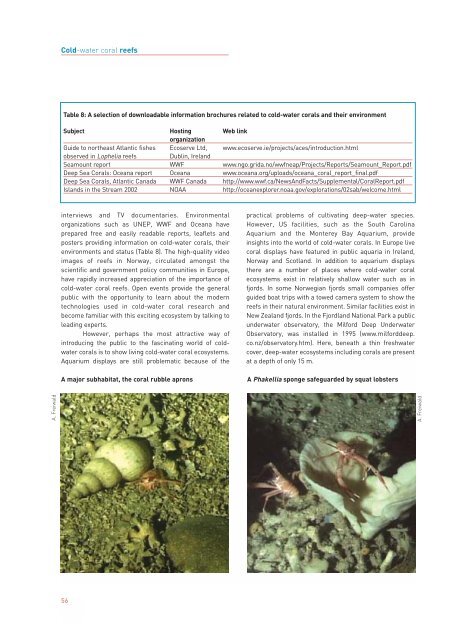Cold-water coral reefs - WWF UK
Cold-water coral reefs - WWF UK
Cold-water coral reefs - WWF UK
Create successful ePaper yourself
Turn your PDF publications into a flip-book with our unique Google optimized e-Paper software.
<strong>Cold</strong>-<strong>water</strong> <strong>coral</strong> <strong>reefs</strong><br />
Table 8: A selection of downloadable information brochures related to cold-<strong>water</strong> <strong>coral</strong>s and their environment<br />
Subject Hosting Web link<br />
organization<br />
Guide to northeast Atlantic fishes Ecoserve Ltd, www.ecoserve.ie/projects/aces/introduction.html<br />
observed in Lophelia <strong>reefs</strong><br />
Dublin, Ireland<br />
Seamount report <strong>WWF</strong> www.ngo.grida.no/wwfneap/Projects/Reports/Seamount_Report.pdf<br />
Deep Sea Corals: Oceana report Oceana www.oceana.org/uploads/oceana_<strong>coral</strong>_report_final.pdf<br />
Deep Sea Corals, Atlantic Canada <strong>WWF</strong> Canada http://www.wwf.ca/NewsAndFacts/Supplemental/CoralReport.pdf<br />
Islands in the Stream 2002 NOAA http://oceanexplorer.noaa.gov/explorations/02sab/welcome.html<br />
interviews and TV documentaries. Environmental<br />
organizations such as UNEP, <strong>WWF</strong> and Oceana have<br />
prepared free and easily readable reports, leaflets and<br />
posters providing information on cold-<strong>water</strong> <strong>coral</strong>s, their<br />
environments and status (Table 8). The high-quality video<br />
images of <strong>reefs</strong> in Norway, circulated amongst the<br />
scientific and government policy communities in Europe,<br />
have rapidly increased appreciation of the importance of<br />
cold-<strong>water</strong> <strong>coral</strong> <strong>reefs</strong>. Open events provide the general<br />
public with the opportunity to learn about the modern<br />
technologies used in cold-<strong>water</strong> <strong>coral</strong> research and<br />
become familiar with this exciting ecosystem by talking to<br />
leading experts.<br />
However, perhaps the most attractive way of<br />
introducing the public to the fascinating world of cold<strong>water</strong><br />
<strong>coral</strong>s is to show living cold-<strong>water</strong> <strong>coral</strong> ecosystems.<br />
Aquarium displays are still problematic because of the<br />
A major subhabitat, the <strong>coral</strong> rubble aprons<br />
practical problems of cultivating deep-<strong>water</strong> species.<br />
However, US facilities, such as the South Carolina<br />
Aquarium and the Monterey Bay Aquarium, provide<br />
insights into the world of cold-<strong>water</strong> <strong>coral</strong>s. In Europe live<br />
<strong>coral</strong> displays have featured in public aquaria in Ireland,<br />
Norway and Scotland. In addition to aquarium displays<br />
there are a number of places where cold-<strong>water</strong> <strong>coral</strong><br />
ecosystems exist in relatively shallow <strong>water</strong> such as in<br />
fjords. In some Norwegian fjords small companies offer<br />
guided boat trips with a towed camera system to show the<br />
<strong>reefs</strong> in their natural environment. Similar facilities exist in<br />
New Zealand fjords. In the Fjordland National Park a public<br />
under<strong>water</strong> observatory, the Milford Deep Under<strong>water</strong><br />
Observatory, was installed in 1995 (www.milforddeep.<br />
co.nz/observatory.htm). Here, beneath a thin fresh<strong>water</strong><br />
cover, deep-<strong>water</strong> ecosystems including <strong>coral</strong>s are present<br />
at a depth of only 15 m.<br />
A Phakellia sponge safeguarded by squat lobsters<br />
A. Freiwald<br />
A. Freiwald<br />
56
















